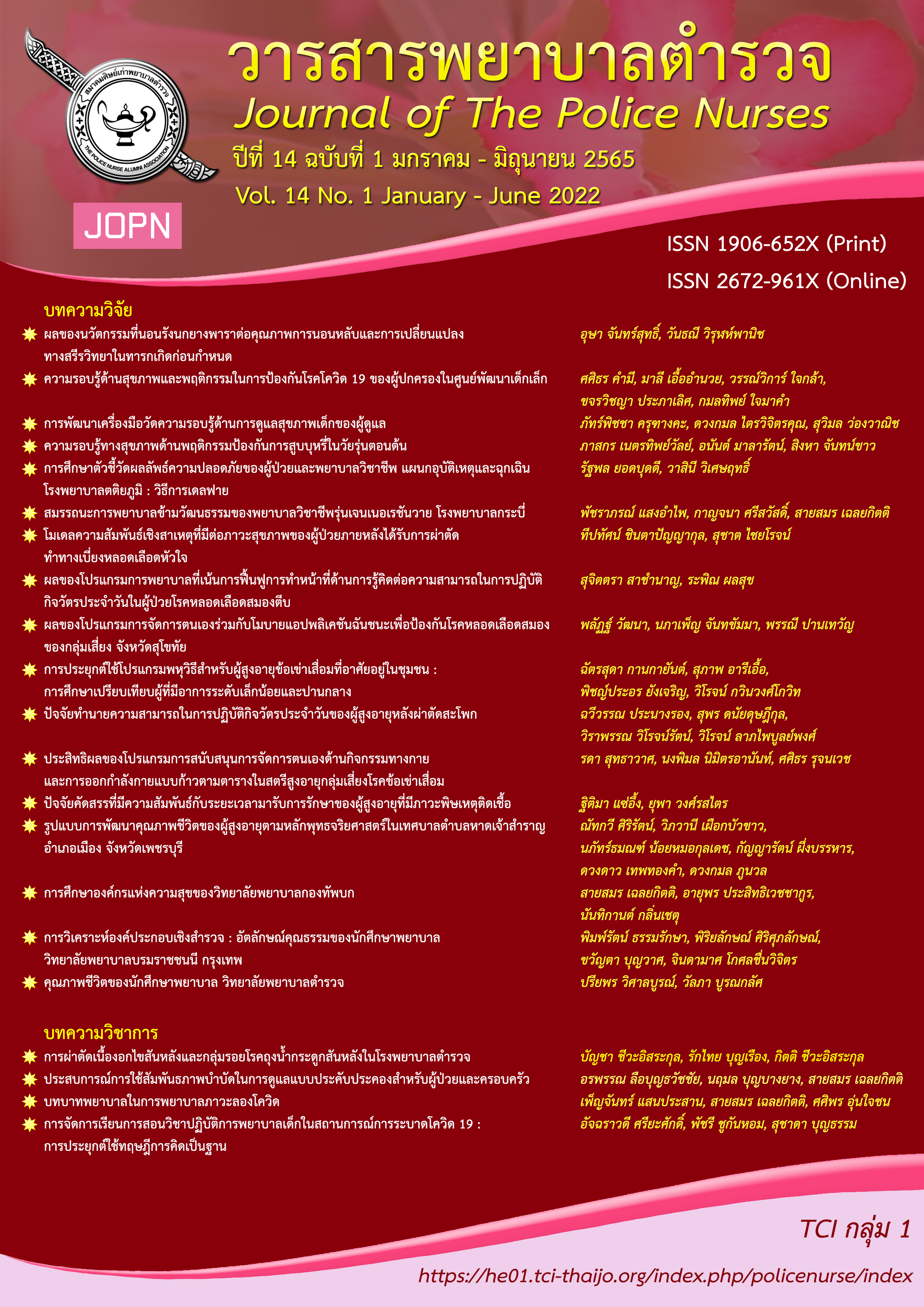FACTORS PREDICTING ACTIVITIES OF DAILY LIVING IN OLDER ADULTS AFTER HIP SURGERY
Keywords:
hip fracture, quality of sleep, nutritional status, activities of daily living, older adultsAbstract
This predictive research was conducted to predict the effects of postoperative pain, quality of sleep, and nutritional status support on the activities of daily living in older adults after hip surgery. The samples in this study were older adults who had undergone surgical treatment of hip fractures in three tertiary hospitals. The purposive samples were a total of 77 older adults. The instruments used in this study consisted of the Visual Analog Scale, Pittsburgh Sleep Quality Index, Mini Nutritional Assessment – Short Form, and Modified Barthel Activities of Daily Index. Pittsburgh Sleep Quality Index, Mini Nutritional Assessment – Short Form, and Modified Barthel Activities of Daily Index were tested for reliabilities and equaled .79, .93, and .87, respectively. The data were analyzed using descriptive statistics and multiple linear regressions statistics.
The results of this study revealed that 66.2% of the sample had mild postoperative pain. Meanwhile, 72.7% of the sample experienced poor quality of sleep. Then, 49.4% of the sample were at risk for malnutrition. Finally, 66.2% of the sample were slightly dependent on other people. Postoperative pain, quality of sleep, and nutritional status were able to be utilized to co-predict the activities of daily living of older adult patients after hip surgery at 24% (R = .49, R2 = .24, R2Adjust =.20, F(3, 73)=7.47, p =.000)
Downloads
References
Büttner, M., Mayer, A. M., Büchler, B., Susanne, S., Betz, U., & Drees, P. (2020). Economic analyses of fast-track total hip and knee arthroplasty: A systematic review. European Journal of Orthopaedic Surgery and Traumatology, 30(1), 67-74. https://www.doi.org/10.1007/s00590-019-02540-1
Buysse, D. J., Reynolds III, C. F., Monk, T. H., Berman, S. R., & Kupfer, D. J. (1989). The Pittsburgh sleep quality index: A new instrument for psychiatric practice and research. Psychiatry research, 28(2), 193-213. https://www.doi.org/10.1016/0165-1781(89)90047-4
Cho, M-R., Song, S-K., & Ryu, C-H. (2020). Sleep disturbance strongly related to the development of postoperative delirium in proximal femoral fracture patients aged 60 or older. Hip & pelvis, 32(2), 93-98.
Harris, M. J., Brovman, E. Y., & Urman, R. D. (2019). Clinical predictors of postoperative delirium, functional status, and mortality in geriatric patients undergoing non-elective surgery for hip fracture. Journal of clinical anesthesia, 58, 61-71.
Hochreiter, J., Kindermann, H., Georg, M., Ortmaier, R., & Mitterer, M. (2020). Sleep improvement after hip arthroplasty: A study on short-stem prosthesis. International Orthopaedics, 44(1), 69.
Jirapramukpitak, T., & Tanchaiswad, W. (1997). Sleep disturbances among nurses of Songklanagarind Hospital. Journal of the Psychiatrist Association of Thailand, 42, 122-31.
Jitapunkul, S., Kamolratanakul, P., & Ebrahim, S. (1994). The meaning of activities of daily living in a Thai elderly population: Development of a new index. Age and ageing, 23(2), 97–101.
Kumdech, P., Jitramontree, N., Wirojratana. V., & Thosingha, O. (2018). Predicting factors on functional recovery post operative hip fracture in older persons. Journal of The Royal Thai Army Nurses, 19(2), 143-151.
Li, H., Fan, J., Gan, L., Wang, Y., Liu, Y., & Li, Q. (2020). Effects of a fast track surgery nursing program in perioperative care of older patients with a hip fracture. European Geriatric Medicine. https://www.doi.org/10.1007/s41999-020-00298-y
Ganczak, M., Chrobrowski, K., & Korzen, M. (2018). Predictors of a change and correlation in activities of daily living after hip fracture in elderly patients in a community hospital in Poland: A six-month prospective cohort study. International journal of environmental research and public health, 15(1), 95.
Mariconda, M., Costa, G. G., Cerbasi, S., Recano, P., Orabona, G., Gambacorta, M., & Misasi, M. (2016). Factors predicting mobility and the change in activities of daily living after hip fracture: A 1-year prospective cohort study. Journal of Orthopaedic Trauma, 30(2), 71-77.
Meleis, A. I. (2010). Transitions theory: Middle-range and situation-specific theories in nursing research and practice: Springer.
Mingphanaz, R., Khetpanya, T., Kanmali, Y., & Khemla, W. (2020). Development of Clinical Nursing Practice Guidelines for Pain Management in the Elderly with Hip Arthroplasty. The Journal of Faculty of Nursing, Burapha University, 28(2), 1-15.
National Statical Office. (2019). Demography population and housing statistics. Retrieved from http://statbbi.nso.go.th/staticreport/page/sector/th/01.aspx
Nishioka, S., Wakabayashi, H., & Momosaki, R. (2018). Nutritional status changes and activities of daily living after hip fracture in convalescent rehabilitation units: A retrospective observational cohort study from the Japan rehabilitation nutrition database. Journal of the Academy of Nutrition and Dietetics, 118(7), 1270-1276.
Pilchta, S. B., & Kelvin, E. A. (2013). Munro’s statistical methods for health care research (6th ed). China: Wolters Kluwer Health/Lippincott Wiliams & Wilkins.
Promchart, L. (2015). The influence of quality of sleep comorbidity and hemoglobin Level on initial ambulatory ability in hip fracture patients after hemiarthroplasty (Master’s Thesis). Retrieved from https://dric.nrct.go.th/Search/ShowFulltext/2/293152
Rubenstein, L. Z., Harker, J. O., Salvá, A., Guigoz, Y., & Vellas, B. (2001). Screening for undernutrition in geriatric practice: Developing the Short-Form Mini-Nutritional Assessment (MNA-SF). The Journals of Gerontology: Series A: Biological Sciences and Medical Sciences, 56(6), 366-372. https://www.doi.org/10.1093/gerona/56.6.M366
Sawa, Y., Kayashita, J., & Nikawa, H. (2020). Occlusal support is associated with nutritional improvement and recovery of physical function in patients recovering from hip fracture. Gerodontology, 37(1), 59-65.
Srichang, N., & Kawee, L. (2016, September 14). Forecast of falls in the elderly (aged 60 years and over) in Thailand, 2017 – 2021. Retrieved from http://www.thaincd.com/2016/mission/documents-detail.php?id=12095&tid=39&gid=1-027
Trongsakul, S., Lambert, R., Clark, A., Wongpakaran, N., & Cross, J. (2015). Development of the Thai version of MiniCog, a brief cognitive screening test. Geriatrics & Gerontology International, 15(5), 594-600.
van Meirhaeghe, J. P., Salmon, L. J., O'Sullivan, M. D., Gooden, B. R., Lyons, M. C., Pinczewski, L. A., & Roe, J. P. (2021). Improvement in sleep patterns after hip and knee arthroplasty: A prospective study in 780 patients. The Journal of Arthroplasty, 36(2), 442-448. https://www.doi.org/10.1016/j.arth.2020.08.056
Worapong, S., Nuttorn, D., Surapot, S., Nattaphon, P., Prapan, C., Kaiwan, S., & Krairoek, W. (2019). Epidemiology of fragility hip fractures in Nan, Thailand. Osteoporosis and Sarcopenia, 5(1), 19-22. https://www.doi.org/10.1016/j.afos.2019.03.003
Yagi, T., Okano, I., Kuroda, T., Ishikawa, K., Nagai, T., Inagaki, K., & Oshita, Y. (2020). Controlling nutritional status score predicts postoperative complications after hip fracture surgery. BMC Geriatrics, 20(1), 243. https://www.doi.org/10.1186/s12877-020-01643-3
Downloads
Published
How to Cite
Issue
Section
License
Copyright (c) 2022 JOURNAL OF THE POLICE NURSES

This work is licensed under a Creative Commons Attribution-NonCommercial-NoDerivatives 4.0 International License.
ผลงานที่ได้ตีพิมพ์แล้วจะเป็นลิขสิทธิ์ของวารสารพยาบาลตำรวจ















